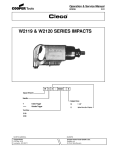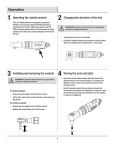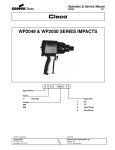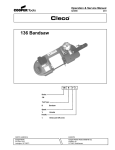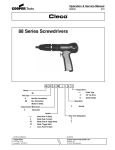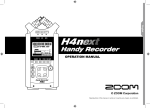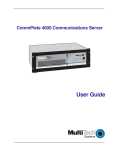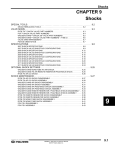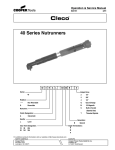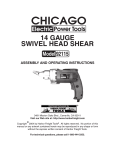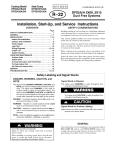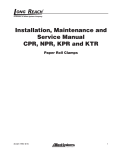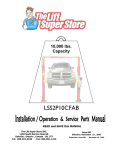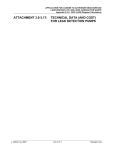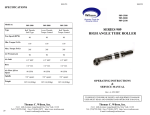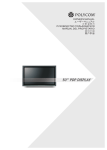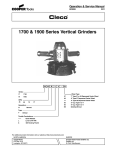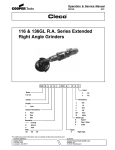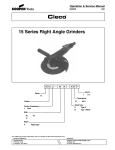Download W2109 & W2110 SERIES IMPACTS
Transcript
Operation & Service Manual
823035
2/01
W2109 & W2110 SERIES IMPACTS
W
X
X
-
XXXX X
-
X
-
XX
Impact Wrench:
Optional Equipment:
6E 6" Extended Spindle
3E 3" Extended Spindle
Handle:
P
Pistol Grip
Output Drive:
T
Inside Trigger
Outside Trigger
8
1"
S
Spline Drive (No. 5 Spline)
Tool Size:
2109
2110
Tool Generation:
B
Concept
Second
NORTH AMERICA
EUROPE
CooperTools
P.O. Box 1410
Lexington, SC 29071
Cooper Power Tools GmbH & Co.
Postfach 30
D-73461 Westhausen
1
SafetyRecommendations
For your safety and the safety of others, read and understand
the safety recommendations before operating an impact wrench.
Never use the air hose for supporting, lifting, or lowering the tool.
Use a safety line or cable on the tool when working in elevated
areas.
Always wear protective equipment and clothing.
!
WARNING
Impact resistant eye protection
must be worn while operating
or working near this tool.
For additional information on eye protection, refer to Federal
OSHA Regulations, 29 CFR, Section 1910.133, Eye and Face
Protection, and ANSI Z87.1, Occupational and Educational Eye
and Face Protection. This standard is available from the American National Standards Institute, Inc., 11 West 42nd Street,
New York, NY 10036.
Tools with exposed throttles should not be used where obstructions can hold the throttle in the "on" position. An impact wrench
operating in reverse will move backwards as a nut is removed
and can trap an operator's hand, making it difficult to release an
outside trigger. Inside trigger or pistol grip tools are advised for
close quarter operation.
Outside Trigger
Rev.
Pistol Grip
Rev.
DO NOT USE!
!
CAUTION
Personal hearing protection is
recommended when operating
or working near this tool.
Hearing protection is recommended in high noise areas (above
85 dBA). Close proximity of additional tools, reflective surfaces,
process noises, and resonant structures can substantially contribute to the sound level experienced by the operator. Proper
hearing conservation measures, including annual audiograms
and training in the use and fit of hearing protection devices may
be necessary. For additional information on hearing protection,
refer to Federal OSHA Regulations, 29 CFR, Section 1910.95,
Occupational Noise Exposure, and American National Standards Institute, ANSI S12.6, Hearing Protectors.
• Gloves and other protective clothing should be worn as
required, unless they create a greater hazard.
• Do not wear loose fitting clothing, or clothing that may
restrict movement, become entangled or in any way
interfere with the safe operation of the impact.
Cleco impact wrenches are designed to operate on 90 psig (6.2
bar) maximum air pressure. If the tool is properly sized and
applied, higher air pressure is unnecessary. Excessive air
pressure increases the loads and stresses on the tool parts,
sockets, and fasteners and may result in breakage. Installation
of a filter-regulator-lubricator in the air supply line ahead of the
tool is highly recommended.
Before the tool is connected to the air supply, check the throttle
for proper operation (i.e., throttle moves freely and returns to
closed position). Being careful not endanger adjacent personnel, clear air hose of accumulated dust and moisture. Before
removing a tool from service or changing sockets, make sure
the air line is shut off and drained of air. This will prevent the tool
from operating if the throttle is accidently engaged.
2
OK
Only use sockets designed for use with impact wrenches. Never
use a hand tool socket on an impact wrench. Hand tool sockets
can break, resulting in a hazard from flying pieces. Inspect
sockets, retainers, and drives regularly for wear or damage, and
replace as necessary. Worn sockets reduce power, cause drive
wear, and increase the chance for breakage and should not be
used.
Impact wrenches equipped with the spline drive have an integral
socket retainer pin which may be depressed by a screwdriver or
similar tool when installing or removing a socket. Tools with
square drives 3/4" and larger use an aor- ring and pin for socket
retention. Retainers—either pin or integral—should be properly
engaged to prevent dropping sockets into lower working levels.
Always use socket retainer components recommended by the
socket manufacturer. Never substitute wire, nails, or welding
rods for retaining pins because they are dangerous if thrown
from the tool at free speed, or if the protruding nail or wire is
accidently grasped by the operator.
!
WARNING
Repetitive work motions and/or vibration
may cause injury to hands and arms.
Use minimum hand grip force consistent
with proper control and safe operation.
Keep body and hands warm and dry.
Avoid anything that inhibits blood circulation.
Avoid continuous vibration exposure.
Keep wrists straight.
Avoid repeated bending of wrists and hands.
Some individuals may be susceptible to disorders of the hands
and arms when performing tasks consisting of highly repetitive
motions and/or exposure to extended vibration. Cumulative
trauma disorders such as carpal tunnel syndrome and tendonitis may be caused or aggravated by repetitious, forceful exertions of the hands and arms. Vibration may contribute to a
condition called Raynaud's Syndrome. These disorders develop gradually over periods of weeks, months, and years. It is
SafetyRecommendations
•
Stressful postures should be avoided. Select a tool
appropriate for the job and work location.
The following suggestions will help reduce or moderate the
effects of repetitive work motions and/or extended vibration
exposure.
• Use a minimum hand grip force consistent with proper
control and safe operation
• Keep body and hands warm and dry
• Avoid anything that inhibits blood circulation
—Smoking Tobacco
—Cold Temperatures
—Certain Drugs
• Keep wrists as straight as possible
• Avoid highly repetitive movements of hands and wrists,
and continuous vibration exposure
WARNING
!
OVER
Repetitive work motions and/or vibration
can cause injury to hands and arms.
Use minimum hand grip force consistent with
proper control and safe operation.
Keep body and hands warm and dry.
Avoid anything that inhibits blood circulation.
Avoid continuous vibration exposure.
Keep wrists straight.
Avoid repeated bending of wrists and hands.
CAUTION
!
Personal hearing protection is
recommended when operating
or working near this tool.
Hearing protection is recommended in high noise
areas (above 85 dBA). Close proximity of other
tools, reflective surfaces, process noises, and
resonant structures can substantially contribute
to the sound level experienced by the user.
WARNING
• Tasks should be performed in such a manner that the
wrists are maintained in a neutral position, which is not
flexed, hyperextended, or turned side to side.
Warnings
The warnings found on these tools are an essential part of the
product. Warnings should be checked periodically for ligibility.
Replace warnings when missing or when the information can no
longer be read. Replacements can be ordered as any spare
part.
!
GOOD POSTURE
This information is a compilation of general safety practices
obtained from various sources available at the date of production. However, our company does not represent that every
acceptable safety practice is offered herein, or that abnormal or
unusual circumstances may not warrant or require additional
procedures. Your work may require additional specific safety
procedures. Follow these procedures as required by your
company.
Impact resistant eye protection
must be worn while operating
or working near this tool.
BAD POSTURE
Also note that various tool wraps are available from a number
of different manufacturers. Like gloves, these wraps are also
intended to reduce and moderate the effects of extended
vibration exposure. They vary widely in design, material, thickness, vibration reduction, effectiveness, and durability, so consideration must be given to choosing the proper wrap for the
specific application.
Read Operating Instructions carefully. Follow
the Safety Recommendations for your safety
and the safety of others.
Tool operators should be aware of the following warning signs
and symptoms so that a problem can be addressed before it
becomes a debilitating injury. Any user suffering prolonged
symptoms of tingling, numbness, blanching of fingers, clumsiness or weakened grip, nocturnal pain in the hand, or any other
disorder of the shoulders, arms, wrists, or fingers is advised to
consult a physician. If it is determined that the symptoms are job
related or aggravated by movements and postures dictated by
the job design, it may be necessary for the employer to take
steps to prevent further occurrences. These steps might include, but are not limited to, repositioning the workpiece or
redesigning the workstation, reassigning workers to other jobs,
rotating jobs, changing work pace, and/or changing the type of
tool used so as to minimize stress on the operator. Some tasks
may require more than one type of tool to obtain the optimum
operator/tool/task relationship.
Work gloves with vibration reducing liners and wrist supports
are available from some manufacturers of industrial work
gloves. These gloves are designed to reduce and moderate the
effects of extended vibration exposure and repetitive wrist
trauma. Since they vary widely in design, material, vibration
reduction, and wrist support qualities, it is recommended that
the glove manufacturer be consulted for gloves designed for
your specific application. WARNING! Proper fit of gloves is
important. Improperly fitted gloves may restrict blood flow
to the fingers and can substantially reduce grip strength.
Do not remove this tag until
the operator of this tool has
read these safety precautions.
presently unknown to what extent exposure to vibrations or
repetitive motions may contribute to the disorders. Hereditary
factors, vasculatory or circulatory problems,exposure to cold
and dampness, diet, smoking and work practices are thought to
contribute to the conditions.
869976
For more information, see the latest edition of ANSI B186.1,
Safety Code for Portable Air Tools, available from the
American National Standards Institute, Inc., 11 West 42nd
Street, New York, NY 10036.
These operating instructions and service manual should
accompany tool if it is subsequently sold or ownership is
changed.
3
GENERAL INFORMATION
AIR SUPPLY
Thetool isdesigned to operate on 90 psig (6.2 bar) airpressure
(measured at the tool air inlet with the tool running) using a
1/2" (12.7mm) hose up to 8' (2.4m) in length. An automatic
in-line filter-lubricator is highly recommended to supply the
tool with cleanlubricated air. This will keepthe tool in sustained operation and increase its service life.
The air hose should be cleared of accumulated dirt and
moisture, then one (1) teaspoon (5ml) of 1 OW machine oil
should be poured into the tool's air inlet before connection
the hose to the tool.
IMPORTANT: If a puick-disconnect coupling is used with
the tool, it should be separated from the tool by a whip hose.
All tools and hoses should be installed by trained, competent personnel. Hoses and fittings should be inspected
regularly for worn or damaged areas and replaced if necessary.
LUBRICATION
An automatic in-line filter-lubricator is recommended as it
increases tool fif e and keeps the tool in sustained operation. The
in-line lubricator should be regularly checked and filled with
a good grade of 1 OW machine oil. Proper adjustment of the
in-line lubricator is performed by placing a sheet of paper
next to the exhaust ports and holding the throttle open
approximately 30 seconds. The lubricator is properly set
when a light stain of oil collects on the paper. Excessive
amounts of oil should be avoided. In the event an in-line
lubricator is not used, the oil reservoir in the handle should
be utilized.
The oil reservoir marked "30W oil" should not require
attention until thetool istorn down for inspection purposes;
however, if the tool is on the application for an unduly long
period of time, the plug should be removed and the reservoir
checked for the presence of oil. If oil is required, approximately 1-1/4 fluid ounces (40ml) of 30W oil should be added
to the oil reservoir.
MAINTINANCE - DISASSEMBLY
STORAGE
In the event that it becomes necessary to store the tool for
an extended period of time (overnight, weekend, etc.), it
should receive a generous amount of lubrication atthat time
and again when returned to service. The tool should be
stored in a clean and dry environment.
GENERAL - ALL MODELS
Disconnect the tool from the air supply and unscrew and
remove the four (4) nuts, No. 865006, then remove the
handle assembly, gasket, No. 869293, and the motor clamp
seal, No. 869281, from the rear of the motor unit.
4
Drive the four (4) housing bolts, No. 869288, out the front of
the motor unit. Removing the anvil housing, No. 861721, will
allow the complete impacting mechanism to slip out the
front of the motor unit.
The impact wrench is now separated into four (4) basic
assemblies. See the following paragraphs for commplete
disassembly instructions on these assemblies.
ANVIL HOUSING
For better performance, it is recommended that the anvil
housing seal, No 869289, be replaced during each repair
The seal may be removed by prying it out with a screwdriver
after removing retainer ring, No. 869511.
Should the anvil housing bushing. No. 869273, need replacing the housing seal will have to be removed as outlined
above. Press the housing bushing out the rear of the
housing using a suitable bushing driver.
IMPACT MECHANISM
Clamp the hammer, No. 869303, horizontally in a softjawed
vise and drive the anvil* away from the hammer using a soft
hammer. This will allow the anvil pin, No. 869290, spring
clip, No 869274, hammer spring, No. 869282, to be removed from the front of the cam shaft, No. 869292.
Remove the hammer from the vise and slip the cam shaft
and related components out of the rear of the cam, No.
869296. Remove the shock absorber, No 867980, (slight
press fit) from the rear of the cam shaft. This will allow the
insulator, No. 869012, butt plate, No. 869011, cam roller,
No 869278 and cam roller shaft, No 869277. to be removed
from the cam shaft Slip the cam, No. 869296, out of the rear
of the hammer, being careful not to lose the timing pin, No.
869279
*NOTE On the spline drive anvils, should any of the socket
retainer parts need replacing, a 5/32'' (4mm) hole should be
drilled in the socket retainer plunger, No. 867950,as shown
in Figure 3. Insert a pin punch in the drilled hole and lightly
tap the punch under the socket retainer pin, No. 867951. Pry
on the punch to pop the pin out of its pocket in the plunger.
MOTOR UNIT
Remove the motor unit from the rear of the housing and
disassemble for inspection of parts.
HANDLE ASSEMBLIES
For inspection of the throttle valve seal, No. 867977, unscrew the inlet bushing. This will allow the removal of the
complete throttling mechanism.
If the throttle pin bushing should need replacing, tap the I.D.
of the bushing with a 114-20 (6m) thread tap. Insert a 1/420 (6mm) bolt of the appropriate length and clamp the bolt
in the vise. Drive the handle away from the vise using a soft
mallet.
MAINTENANCE - REASSEMBLY
CLEANING AND INSPECTION
All oar[s should be cleaned in a solvent and inspected for
wear or darnage. If rotor blades measure less than 11 32 (8
73mr-n) on either end. they should be replaced. Rotor
bearings should be replaced if they feel rough after cleaning
or show excessive looseness. Rotor shaft seals No 869275,
should be replaced if they are badly worn or are no longer
flexible.
HANDLE ASSEMBLIES
A. Spade Handles
VVInen installing the trigger, use a pin slightly smaller lhan
the hole in the handle to loCate the trigger when driving the
trigger pin, No. 832125, into the handle.
If the throttle pin bushing, No. 864975, was removed, the
new bushing should be pressed in to a depth of 1-5/8'' (4
1.28mm) from the bottom face of the handle.
Inspect the throttle valve seal, No. 867977, for wear or
deterioration. If replacement is necessary, [he new seal
should be pushed (cupped face first) on the throttle valve No
867974, from the taPered end.
The inlet bUshing, No 869283 should be torqued to 150 ft.
lbs (204Nm) rninimurn.
B. Pistol Grip Handle
It the throttle pin bushing, No. 832211. was removed, the
new bushing ShOLM be pressed in to a depth of 1-151/ 16
(49 2 1 mr-n) from the bottom face of the handle and the I
D of the bushing sized to 1880''/.1887'' dia. (4.775mm 4
793mm) after installation.
Inspect the throttle valve seal, No. 867977, for wear or
deterioration. If replacement is necessary, the new seal
should be pushed (cupped face first) on the throttle valve,
No 867974, from the tapered end.
Inspect the ''C'' ring, No. 863009, and replace if necessary.
Clean the threads in the handle arid on the inlet bushing and
apply Locktite'' No. 271 to the threads. Torque the bushing
to 80 ft lbs. (109Nm) minimum.
MOTOR UNIT
During assembly of the bearing plates, the rotor shaft seals,
No 869275, should be pressed into the bearing plates with
their ''lips" facing outward (visible after assembly). Pressing
on the OUter race, install the rotor bearings, No. 863097.
into the bearing plate.
Lubricate both the bearings arid seals with 30W oil and
install the rotor, No. 869299, with the end stamped ~i rear''
into one of the bearing plate assemblies (both bearing
plates are identical). Insert the six (6) rotor blades into the
blade slots and place the cylinder on the assembly with the
air inlet holes down. Assemble the other bearing plate on the
front of the rotor and install "0'' ring, No. 619751, on this
bearing plate. Lubricate this "C" ring and the two (2) ''0''
rings, No. 844312, in the motor bore. Place the motor unit
on flat surface. front end up, and slide the motor housing
down over the motor unit with the alignment pin, No. 864117
in place.
IMPACT MECHANISM
All parts should receive a thin coating of 30W oil before
assembly. Insert the timing pin, No. 869279 into the. recess
located on the small O.D. of the cam, No. 869296, and then
install the cam and pin into the rear of the hamr-ner, No.
869303.
Install the cam roller shaft, No. 869277, in the cam shaft, No.
869292. Put the cam roller, No. 869278, on the roller shaft
and slip the butt plate, No. 869011, insulator, No. 869012,
and shock absorber, No. 867980, onto the rear of the cam
shaft. Hold the cam shaft vertically on the work bench with
the shock absorber down and tap the end of the cam shaft
with a soft mallet to seat the cam shaft in the shock
absorber.
Slip the cam shaft and related components through the cam
and hammer assembly. Install the hammer spring, No.
869282, spring clip, No. 869274, and anvil pin, No. 869290,
onto the front of the cam shaft and hammer assembly.
Rotate the spring clip to accept the anvil pin and then install
the anvil on top of the assembly (be sure the slot in the anvil
lines up with the anvil pin) and drive the anvil down until the
spring clip engages the recess in the anvil
To install the socket retainer pin, No. 867951, in the spline
drive anvil insert socket retainer spring, No. 867949, and
socket retainer plunger, No. 867950, into the anvil and then
drive the socket retainer pin radially into the plunger
ANVIL HOUSING
When replacing the anvil housing seal, No. 869289, the
housing bore should be cleaned with a solvent and then
coated with "PERMATEX" Aviation Form-A-Gasket No. 3H,
and then be allowed to air dry at least four (4) minutes before
5
of the cam shaft. Hold the cam shaft vertically on the work
bench with the shock absorber down and tap the end of the
cam shaft with a soft mallet to seat the cam shaft in the
shock absorber.
Slip the cam shaft and related components through the cam
and hammer assembly. Install the hammer spring, No.
869282, spring clip, No. 869274, and anvil pin, No. 869290,
onto the front of the cam shaft and hammer assembly.
Rotate the spring clip to accept the anvil pin and then install
the anvil on top of the assembly (be sure the slot in the anvil
lines up with the anvil pin) and drive the anvil down until the
spring clip engages the recess in the anvil
To install the socket retainer pin, No. 867951, in the spline
drive anvil insert socket retainer spring, No. 867949, and
socket retainer plunger, No. 867950, into the anvil and then
drive the socket retainer pin radially into the plunger
ANVIL HOUSING
When replacing the anvil housing seal, No. 869289, the
housing bore should be cleaned with a solvent and then
coated with "PERMATEX" Aviation Form-A-Gasket No. 3H,
and then be allowed to air dry at least four (4) minutes before
pressing in the seal. Press the seal in with its "lip" toward the
bore of the housing. ("Lip" should not be visible after
assembly.)
GENERAL - ALL MODELS
Coat the impact mechanism with 30W oil and insert into the
rotor. Lubricate the anvil housing seal, bushing and front
bearing plate "C'' ring with 30W oil and install the anvil
housing. Install the dead handle, housing bolts, motor
clamp seal, gasket, and handle or back cap, depending on
model. NOTE Upper cut-out on the gasket aligns with the
cylinder slot. Install the four (4) nuts, No 865006, and torque
to 20 ft. lbs. (27Nm) minimum.
After complete assembly of the tool, 1-1/4 fluid ounces
(40ml) of 30W oil should be added to the 30W oil fill hole.
SAFETY CHECK
All tools should be tested after repair or replacement of parts
to assure that they are functioning properly.
DRAWINGS AND PARTS LISTS
OPTIONAL PARTS
6
7
PARTS LIST — IMPACT MECHANISM
PART NO.
203282
842290
861721
861775
861805
861806
865022
867949
867950
867951
867980
869011
869012
869273
869274
8
NAME OF PART
Washer
Support Handle
Anvil Housing (incl. 869273, 869289, 869511)
#5 (1-5/8") Std. Spline Drive Anvil (incl. 867949, 867950,
867951, 869302)
#5 (1-5/8") 3" Ext. Spline Drive Anvil (incl. 867949,
867950, 867951, 869531)
#5 (1-5/8") 6" Ext. Spline Drive Anvil (incl. 867949,
867950, 867951, 869532)
Support Handle Bracket
Socket Retainer Spring
Socket Retainer Plunger
Socket Retainer Pin
Shock Absorber
Butt Plate
Insulator
Anvil Bushing
Spring Clip
QTY.
PART NO.
2
1
1
869277
869278
869279
869282
869288
869289
869290
869292
869296
869301
869302
869303
869508
869509
869511
869531
869532
1
1
1
1
1
1
1
1
1
1
1
1
NAME OF PART
Cam Roller Shaft
Cam Roller
Timing Pin
Hammer Spring
Housing Bolt
Anvil Housing Seal
Anvil Pin
Cam Shaft
Cam
1" Sq. Dr. Anvil (Std.)
#5 (1-5/8") Spline Drive Anvil (Std.)
Hammer
1" Sq. Dr. Anvil (3" Ext.)
1" Sq. Dr. Anvil (6" Ext.)
Retainer Ring
#5 (1-5/8") Spline Drive Anvil (3" Ext.)
#5 (1-5/8") Spline Drive Anvil (6" Ext.)
QTY.
1
1
1
1
4
1
1
1
1
1
1
1
1
1
1
1
1
PARTS LIST — MOTOR UNIT
PART NO.
619751
863097
864117
869275
869280
869281
NAME OF PART
O-ring 2-13/16" X 3"
Rotor Bearing
Alignment Pin
Rotor Shaft Seal
Rotor Blade
Motor Clamp Seal
QTY.
PART NO.
1
2
1
2
6
1
869294
869295
869297
869298
869299
NAME OF PART
2110 Cylinder
2109 Cylinder
2109 Bearing Plate
2110 Bearing Plate
Rotor
QTY.
1
1
1
1
1
9
PARTS LIST — SPADE HANDLES AND MOTOR HOUSING
PART NO.
NAME OF PART
QTY.
PART NO.
203282
619016
832125
842656
844301
844303
844312*
844320*
863637*
864387
864973
864975
865006*
867801
867974
Washer
Retainer Ring
Trigger Pin
Inlet Screen
O-ring 1/8" X 1/4"
O-ring 3/16" X 5/16"
O-ring 5/8" X 13/16"
O-ring 1-1/16" X 1-5/16"
Wear Plate Pin
10W Oil Fill Plug
Throttle Valve Spring
Throttle Pin Bushing
Nut
30W Oil Fill Plug
Throttle Valve
2
1
1
1
1
1
2
1
1
1
1
1
4
1
1
867977
867998
869000
869004*
869009
869266*
869268*
869269*
869270
869271
869276*
869283
869286
869293*
NAME OF PART
Throttle Valve Seal
Inside Trigger
Outside Trigger
Muffler Plate
Trigger Stop Pin
Motor Housing incl. 863637, 869004, 869268, 869269)
Retainer Screw
Wear Plate
Inside Trigger Handle (incl 864975)
Outside Trigger Handle (incl. 864975)
Reversing Valve
Inlet Bushing
Throttle Pin
Gasket
*Denotes parts not included in subassemblies listed below.
The complete spade handle can be ordered as a subassembly using the part numbers listed below.
Outside Trigger - 861723
Inside Trigger - 861724
10
QTY.
1
1
1
3
1
1
1
1
1
1
1
1
1
1
PARTS LIST — PISTOL GRIP MOTOR HOUSING
PART NO.
NAME OF PART
QTY.
PART NO.
412775
617288
832211
842320
843590
844303
844310
844312
847688
863009
863072
864387
864972
Air Screen
Air Screen Retainer Ring
Throttle Pin Bushing
Pin
Oiler Bushing
O-ring 3/16" X 5/16"
O-ring 1/2" X 11/16"
O-ring 5/8" X 13/16"
Muffler Screw
O-ring 3/4" X 7/8"
Throttle Valve Spring
Oiler Plug (10W)
Inlet Bushing
1
1
1
2
1
1
1
2
2
1
1
1
1
865006*
867801*
867974
867977
869265*
869285*
869287
869291*
869526*
869618
869619
NAME OF PART
QTY.
Nut
Oil Fill Plug (30W)
Throttle Valve
Throttle Valve Seal
Backcap (incl. 867801)
Reversing Valve
Throttle Rod
Muffler
Gasket
Motor Housing (incl. 832211, 843590)
Trigger
4
1
1
1
1
1
1
1
1
1
1
*Denotes parts not included in subassemblies listed below.
The complete pistol grip motor housing can be ordered as a subassembly using the part number listed below.
861808
11
CooperTools
670 Industrial Drive
Lexington, SC 29072
Phone: (803) 359-1200
Fax: (803) 359-2013
www.cooperindustries.com
12












